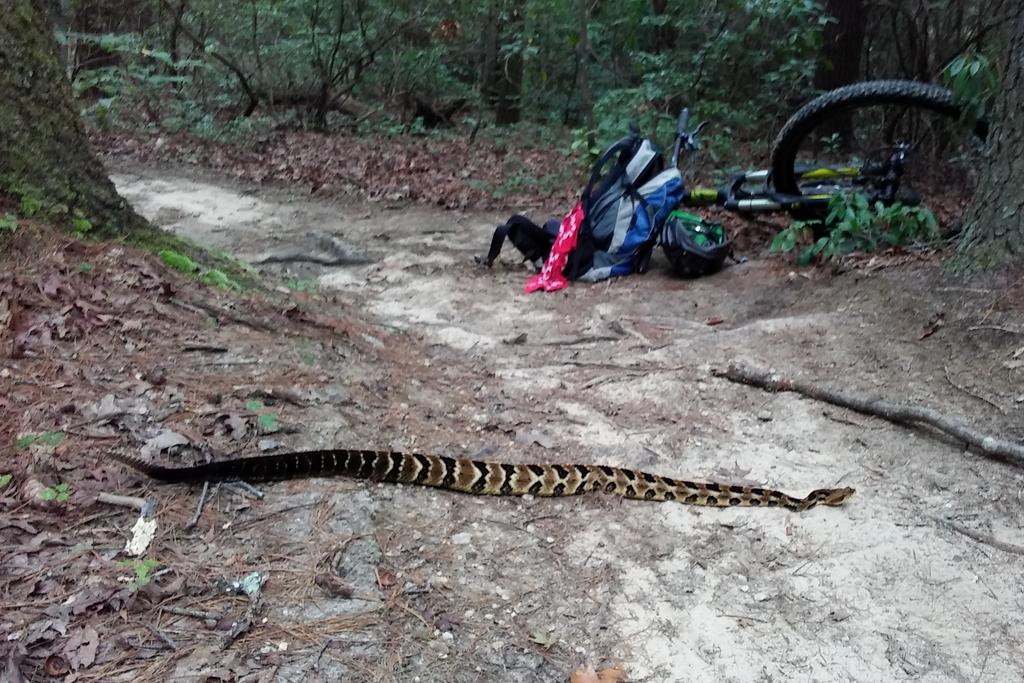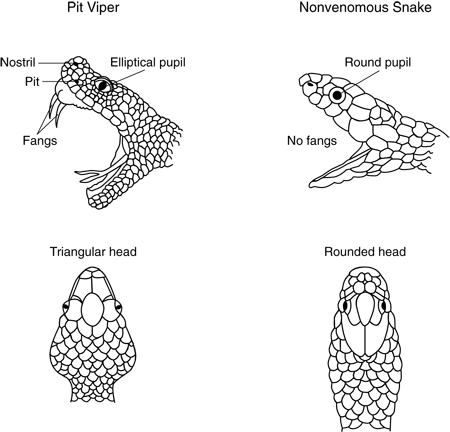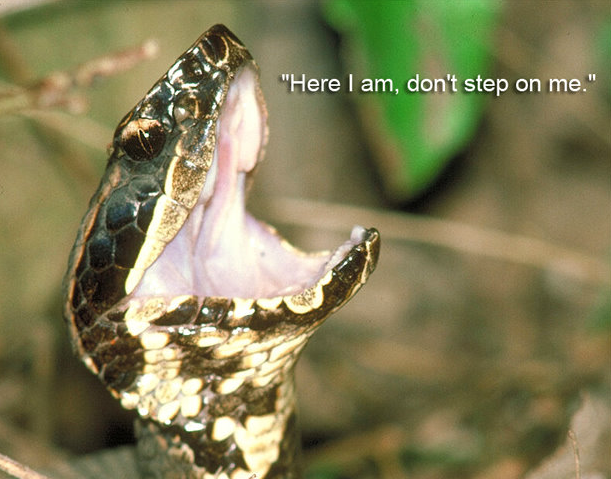4 Ways to Tell if A Snake is Venomous
Snakes. Bleh!
In our previous articles, we showed you how to predict when snakes come out of hibernation When is Snake Season? A Complete Guide to Predicting Snake Sightings and also gave you a few tips for avoiding snakes when they are in peak season 5 Ways to Avoid Snake Bites.
But if you play outdoors and the thermometer at your local bank reads above 70 degrees Farenheit, chances are good you will eventually run into a snake.
There is not much we can say to lessen the initial shock you will feel after realizing that the stick lying across trail is looking at you. But after that initial hit of adrenaline, your brain will repossess your senses, and your first thought will likely be “Is that snake poisonous?”
What your mind meant to ask is, “Is that snake venomous?” The difference is that poison is ingested (i.e you eat the snake) and venom is injected (i.e. the snake bites you). Rein it in here, author…
Here’s how to answer that question. We have broken snake identification into four categories. Some are quick and easy, but have exceptions. Some are completely accurate, but difficult to remember. We will give you all the options, you chose your style.
Read through the whole thing or jump around and find the section that suits you best.
Quick Overview
This is a guide for describing venomous snakes in North America. We focus on those in the USA. If you are looking for information on taipans, death adders, boomslangs, or any other of the non-occidental, garden-variety, armless, hell beasts please look elsewhere. If you are looking for information on the black mamba, please read this inspirational biography on one of the NBA’s greatest point guards, Kobe Bryant.
For those of you looking for a quick-and-dirty method that will identify 95% of North American hell beasts, er, venomous snakes, we’ve got that. See #1. If you want a quick-and-dirty method AND you happen live within spitting distance of the Gulf of Mexico, make sure to read #2 as well.
If that 5% uncertainty still makes you nervous, you have a background in biology, or were good at the game Memory, #3 is for you. As a caution, don’t read that section before bed or if you have recently changed the prescription of your glasses that would allow you to see pictures of snakes in disturbingly crisp detail.
If you are ophidiophobic, xylophobic, or just agoraphobic, but can’t quit the trail, go to #4.
1. Learn the Rules: Describing the Pit Viper
The most common type of venomous snake in the USA in the pit viper, so called because of the sensitive “pit organs” between each eye and nostril, which helps it sense and strike warm-blooded prey. There are three good ways of telling if you are looking at a pit viper.
Fat, Triangular Head | Many snakes, even non-venomous ones will have a naturally tapered and triangular head. Venomous snakes have to carry around venom sacks, which gives them some beefy heads. In addition, many of these pit vipers will have a narrowing of the neck just before the head.
Divot Between The Eyes | We’re talking about the sensing pits here. If you can’t see these from where you are safely standing, don’t get closer. A coiled snake can strike up to two-thirds its body length.
Slitted Eyes | Venomous snakes will have slitted, or elliptical eyes, much like a cats. Non-venomous snakes will have round, teddy bear eyes. Again, mind the gap between you and the specimen.
Rattle | Ok, this doesn’t apply to all pit vipers, but I’ll include anyway. If its tail is rattling, it’s venomous. Shaking the tail is a pretty common defense mechanism for snakes, even the non-venomous variety. And sometimes, if those snakes are around dry leaves/grass, it can make a rattling sound. But trust us on this, you’ll know a rattlesnake sound when you hear it. Its rattle has a hollow, raspy tone that you could easily attribute to Death Eaters had J.K. Rowling seen fit to give them a sound.
2. Learn the Glaring Exception to the Rule: The Coral Snake
Using #1 will help you with 90% of your snake encounters. There is a major exception to those rules and its name is the coral snake. If you are within a gas tank’s drive of the Gulf of Mexico or can walk Arizona to Mexico with less than 12 oz. of water, learn this exception.
Coral snakes have slender heads, round eyes, and no sensing pits. They are easily confused with a number of other fake-looking snakes including the scarlet king snakes and milk snakes, but can be distinguished in two ways. First, there’s a cute little rhyme that goes “Red against yellow: kills a fellow. Red against black: safe for Jack.” The second way is to look for a black nose, which was reserved by God to denote the coral snake.
3. Memorization: The 4 Categories of Venomous Snakes in the USA
If Rules #1 and #2 are too inexact for you or if you are not confident in your ability to spot differences in head contours from 10 feet away, your next best option is to memorize the overall appearance of each of the venomous snakes in the USA. Luckily, there are only 4 categories.
We have included pictures of the usual suspects below. Get to know them.
1. Coral Snakes | Covered. See Rule #2
2. Copperheads | Medium-sized snake 3’-4’ in length with a stout, wide body and broad head. They can be light brown or tan, with dark, irregular banding often resembling triangles. The thing that distinguishes the copperhead from, say, a northern water snake, is its distinctive neck.
Copperheads are hard to see. Their patterning makes them nearly invisible against the forest floor where they often live and they tend to freeze when approached. Their venom is mild, but rarely fatal. Luckily, copperheads are unique in that their first defensive strike usually includes no venom. But if you stick around, the second strike is almost never as kind.
3. Cottonmouths | aka the Water Moccasin, cousin to the copperhead. Medium-sized snake 4-5’ in length with a stocky frame that tapers off quickly at the tail. They are usually a dark brown or light black and sometimes have light banding on their sides. Juvenile cottonmouths may have more distinguished bands resembling, to the laymen, those of the copperhead. There are a bunch of ways to distinguish (read confuse) cottonmouths. Here’s a really useful site if you have an appetite for the esoteric.
There are two dead giveaways that you are looking at a cottonmouth rather than a copperhead, rat snake, northern water snake, etc… The first is that a cottonmouth will do this.
But if any snake does that to you, let’s just call it a day shall we? The second giveaway is if it is doing this.
Cottonmouths are the only semi-aquatic venomous snake in the US. And as opposed to the non-venomous semi-aquatic snakes which swim with their bodies mostly submerged, a cottonmouth can hold its head up while its body floats on the water.
4. Rattlesnakes | There are 32 species of rattlesnakes with 83 subspecies. Short of becoming a herpetologist, the best way to distinguish a rattlesnake from any other snake is to, well, look for the rattle on the tail. Make an exception for the pygmy rattlesnake which has barely noticeable rattles on a yellow tail.
We’re looking at you, pygmy.
Make another exception for baby rattlesnakes, who have not yet shed their first layer of skin which makes an individual rattle, and instead have a “button.”
Instead of showing you 83 pictures of rattlesnakes, I will show you one particularly awful bugger to look out for, the Eastern Diamondback Rattlesnake. I capitalize intentionally. This snake can grow up to 8’ and 35 lbs with fangs as long as an inch.
4. It’s Venomous
Still not convinced you can pick out a venomous snake from a non-venomous one? Here’s a fail-proof method passed down to me from my grandfather and his grandfather before that, and before that all the way back to the 5th century before St. Patrick banished all snakes from Ireland for interrupting his 40-day fast. Are you ready for it?
They’re all venomous. Might as well treat them that way.
Knowledge is power, but if you’re looking for some extra peace of mind on your next excursion check out our Snake Sox, the first snake-proof leg wrap built for adventure.
Do you have better ways to identify venomous snakes? Let us know in the comments!










